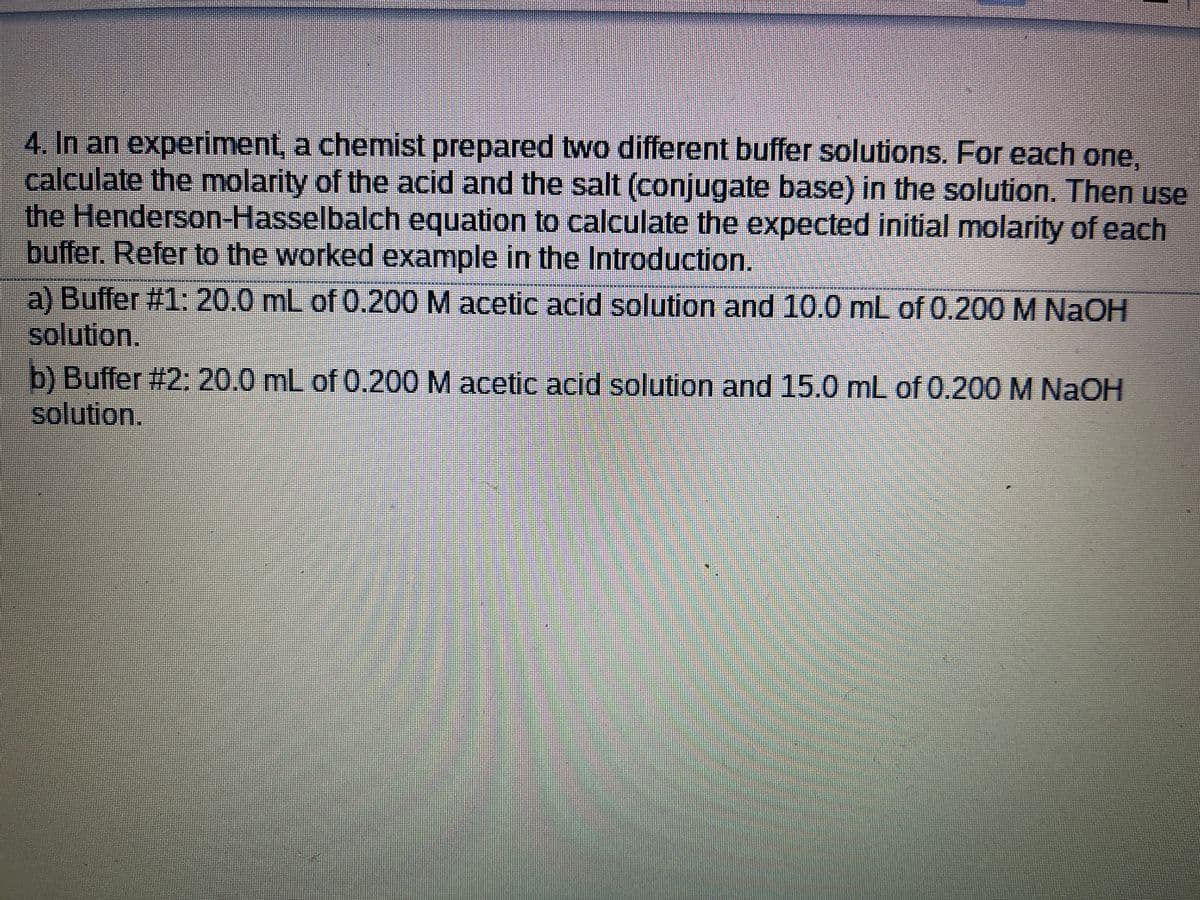4. In an experiment, a chemist prepared two different buffer solutions. For each one, calculate the molarity of the acid and the salt (conjugate base) in the solution. Then use the Henderson-Hasselbalch equation to calculate the expected initial molarity of each buffer. Refer to the worked example in the Introduction. a) Buffer #1: 20.0 mL of 0.200 M acetic acid solution and 10.0 mL of 0.200 M NaOH solution. b) Buffer #2: 20.0 mL of 0.200 M acetic acid solution and 15.0 mL of 0.200 M NaOH solution.
4. In an experiment, a chemist prepared two different buffer solutions. For each one, calculate the molarity of the acid and the salt (conjugate base) in the solution. Then use the Henderson-Hasselbalch equation to calculate the expected initial molarity of each buffer. Refer to the worked example in the Introduction. a) Buffer #1: 20.0 mL of 0.200 M acetic acid solution and 10.0 mL of 0.200 M NaOH solution. b) Buffer #2: 20.0 mL of 0.200 M acetic acid solution and 15.0 mL of 0.200 M NaOH solution.
Chemistry: An Atoms First Approach
2nd Edition
ISBN:9781305079243
Author:Steven S. Zumdahl, Susan A. Zumdahl
Publisher:Steven S. Zumdahl, Susan A. Zumdahl
Chapter14: Acid- Base Equilibria
Section: Chapter Questions
Problem 97AE: A student intends to titrate a solution of a weak monoprotic acid with a sodium hydroxide solution...
Related questions
Question

Transcribed Image Text:4. In an experiment, a chemist prepared two different buffer solutions. For each one.
calculate the molarity of the acid and the salt (conjugate base) in the solution. Then use
the Henderson-Hasselbalch equation to calculate the expected initial molarity of each
buffer. Refer to the worked example in the Introduction.
a) Buffer #1: 20.0 mL of 0.200 M acetic acid solution and 10.0 mL of 0.200 M NAOH
solution.
b) Buffer #2: 20.0 mL of 0.200 M acetic acid solution and 15.0 mL of 0.200 M NaOH
solution.
Expert Solution
This question has been solved!
Explore an expertly crafted, step-by-step solution for a thorough understanding of key concepts.
This is a popular solution!
Trending now
This is a popular solution!
Step by step
Solved in 3 steps

Knowledge Booster
Learn more about
Need a deep-dive on the concept behind this application? Look no further. Learn more about this topic, chemistry and related others by exploring similar questions and additional content below.Recommended textbooks for you

Chemistry: An Atoms First Approach
Chemistry
ISBN:
9781305079243
Author:
Steven S. Zumdahl, Susan A. Zumdahl
Publisher:
Cengage Learning

Chemistry
Chemistry
ISBN:
9781305957404
Author:
Steven S. Zumdahl, Susan A. Zumdahl, Donald J. DeCoste
Publisher:
Cengage Learning


Chemistry: An Atoms First Approach
Chemistry
ISBN:
9781305079243
Author:
Steven S. Zumdahl, Susan A. Zumdahl
Publisher:
Cengage Learning

Chemistry
Chemistry
ISBN:
9781305957404
Author:
Steven S. Zumdahl, Susan A. Zumdahl, Donald J. DeCoste
Publisher:
Cengage Learning


General Chemistry - Standalone book (MindTap Cour…
Chemistry
ISBN:
9781305580343
Author:
Steven D. Gammon, Ebbing, Darrell Ebbing, Steven D., Darrell; Gammon, Darrell Ebbing; Steven D. Gammon, Darrell D.; Gammon, Ebbing; Steven D. Gammon; Darrell
Publisher:
Cengage Learning

Principles of Modern Chemistry
Chemistry
ISBN:
9781305079113
Author:
David W. Oxtoby, H. Pat Gillis, Laurie J. Butler
Publisher:
Cengage Learning

Chemistry: The Molecular Science
Chemistry
ISBN:
9781285199047
Author:
John W. Moore, Conrad L. Stanitski
Publisher:
Cengage Learning